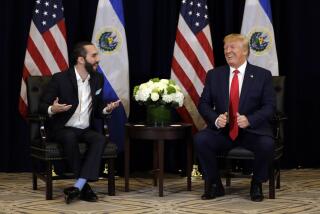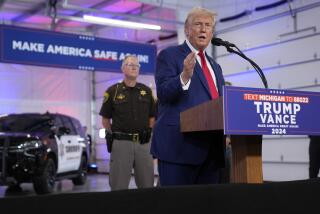How a president is overthrown
- Share via
TEGUCIGALPA, HONDURAS — On Saturday, June 27, the order came down: Arrest the president.
That night, Honduran military officers stopped taking calls from U.S. officials.
At sunrise Sunday, army commanders firing warning shots into the air marched through the back door of the president’s home, rousted him from bed and took him away, still in his pajamas.
It was over in 15 minutes. But the coup that toppled President Manuel Zelaya was a slow boil, over many months, of an increasingly arbitrary and provocative leader, the often-exaggerated fears of a hidebound elite and a military with divided loyalties.
That simmering crisis exploded into one of the most serious challenges facing Latin America in a decade. In some ways, it was a throwback to the old Latin America, when coups and men in uniform more often than not decided who ruled. But it was also emblematic of a struggle underway today on the continent, where a crop of leftist leaders with authoritarian tendencies have risen to power through elections, defied the status quo and tested the bounds of democracy.
The following account is based on interviews with numerous Hondurans and foreigners involved in the coup or the events that led to it. Some details are still in dispute.
::
When he won the presidential election in 2005 by a narrow margin, Zelaya was something of an outsider -- gruff, not fully part of the elite that had always governed. Even Hondurans who admire him, however, say he became enamored of the power he thought he had.
His ticket, he soon decided, was to align himself with the emerging bloc in the region headed by Venezuelan President Hugo Chavez, an erratic, charismatic populist who evokes passionate extremes of admiration and hatred. Zelaya adopted Chavez’s socialist rhetoric, his bluster, even the gimmicky dress. (He started wearing a white cowboy hat as his symbol.)
Zelaya managed to push through legislation that helped the poor and ruffled the elite, including a huge raise in the minimum wage, in a country where 40% of the population lives on less than a dollar a day. But power was more important to him than solid ideology.
“For him, it was all about becoming a big figure,” said Juan Ramon Martinez, a historian and political analyst who had many dealings with Zelaya. “If he had to dance the cha-cha-cha, he’d do it. If he had to spout Marxist rhetoric, he’d do it.”
Ideology might not have been important to Zelaya, but it was to his inner circle, whose members traced their roots to Honduras’ small radical left that emerged in the 1970s. They had gone to university together, fought against the brutal military dictatorships of the day, suffered persecution. Eventually they went into human rights or became lawyers, but didn’t abandon their goals.
They helped coax Zelaya to the left, and last year he stepped firmly into the Chavez camp by joining a group of Latin America’s leftist presidents formed five years ago by the Venezuelan leader and Cuba’s Fidel Castro.
With the old left gaining power, the old right leapt into action, with businessmen and the news media at their service, hitting back at Zelaya relentlessly.
Then came an old trauma. Zelaya began speaking of changing the constitution, and his enemies decided he was making a move to end term limits and so he could stay in office -- much as Chavez had done in Venezuela.
The Honduran Constitution bars presidential reelection, a provision born of a history replete with rulers who overstayed their welcome. Most famously, Tiburcio Carias, a military man with close ties to the foreign-owned fruit companies that made Honduras the original banana republic, rewrote the constitution to stay in office from 1933 to 1949.
In March, Zelaya called for a vote June 28 to weigh support for changing the constitution. Initially, the wording of the convocation was innocuous enough, and momentum built behind the “consulta popular,” as it was being called. It had a lot of support among a disaffected majority for whom Honduras’ 27-year experiment in democracy had failed to improve daily life.
On May 12, the attorney general’s office ruled against holding the vote. Zelaya ignored the order and pressed ahead with his campaign.
Congress, led by Roberto Micheletti, a transportation magnate from Zelaya’s Liberal Party, also opposed the vote. Honduras’ tiny rich class is notoriously loath to share its wealth, and members saw Zelaya’s move to tinker with the constitution as the last straw. They organized street protests and a media blitz against the referendum.
“Never had a ruler so frightened the instruments of political and economic power,” historian Martinez said.
Pressure mounts
In mid-June, events started to veer precipitously toward disaster.
On June 12, the military high command met secretly, pointedly leaving Zelaya out of the loop. Coup rumors that had ricocheted around the capital for weeks grew stronger. Five days later, Zelaya’s defense minister quit, though this development would not be revealed for a week.
Ignoring an appeals court ruling that again declared the June 28 vote illegal, Zelaya announced that the army would help with the election by distributing and collecting ballot boxes.
This threw the army command into turmoil: It was being tasked to carry out an operation that had been judged illegal.
On Thursday, June 25, troops deployed throughout the capital as Congress met to depose Zelaya. Politicians, including Micheletti, worked to put together the legal and constitutional cover to remove a president who was breaking the law.
The next day, La Gaceta, the government’s official register of laws, published the decree convoking the following Sunday’s vote. Zelaya’s enemies contend that the wording of the final decree had been changed in a way that would allow hasty revision of the constitution through a constituent assembly. Non-Honduran analysts say a series of legislative steps would still have been required.
But logic really didn’t matter at this point; the die was cast.
U.S. officials apparently underestimated how serious and how advanced the crisis was. In the final weekend before the coup, they were frantically telephoning Honduran contacts in an attempt to avert it. They spoke on several occasions to commanders of the Honduran army, with which the United States has had a long relationship.
But in the hours before the coup, U.S. officials found they could no longer reach the officers.
A defining move
Juan Ramon Martinez likes to get up early on Sundays. Quiet time to write and think. About dawn on June 28, he was sitting at his computer in his home a block or two from one of President Zelaya’s residences.
Suddenly he heard gunfire. He stepped gingerly out the front door to ask the young watchman what was happening. “Golpe de estado!” the man answered in a loud whisper. A coup. Martinez turned to see a huge soldier in battle dress standing in the street a few feet away. “Get back in your house!” the soldier barked.
Fifteen minutes later, it was over. An army team, under the command of a general and two colonels, had seized Zelaya.
Up to this point, the coup plotters might have been able to justify their actions to the international community by arguing that the military was fulfilling a legitimate court order to arrest the president. What happened next, however, deprived them of that luxury.
The military bundled Zelaya away to a military aircraft. Still in his pajamas, the president was flown to Costa Rica.
Even among some who supported the removal of Zelaya, the decision to expel him went beyond the pale, and the army’s chief juridical advisor now acknowledges that the expulsion was illegal.
“It has made Honduras look bad for an action being taken to benefit a democratic system,” said Jorge Canhuate Larash, one of the country’s most powerful businessmen.
The military has assumed responsibility for what it says was a last-minute decision to remove Zelaya from the country, arguing that to leave him in a prison in Honduras would have invited mobs to attempt to break him free. But many here don’t think they made the decision alone.
It is not clear what kind of role the Roman Catholic Church, another pillar of power and influence here, played before to the coup; Cardinal Oscar Andres Rodriguez Maradiaga was at the Vatican that week. But within days he lent fervent support to the action.
Nine days after the coup and two days after Zelaya attempted unsuccessfully to land at the airport, the cardinal was overheard on his cellphone to the attorney general, urging him to produce drug trafficking evidence against Zelaya. “My son,” he said, “we need that proof. It’s the only thing that will help us now.”
Two days later, one of Latin America’s veteran negotiators, Costa Rican President Oscar Arias, invited Zelaya and Micheletti to his home for talks. But the ousted leader and the man who deposed him refused to sit in the same room.
More talks were vaguely planned, Micheletti flew back to Honduras, and Zelaya bounced around from capital to capital, in any country that would have him.
--
Special correspondent Alex Renderos contributed to this report.
More to Read
Sign up for Essential California
The most important California stories and recommendations in your inbox every morning.
You may occasionally receive promotional content from the Los Angeles Times.











